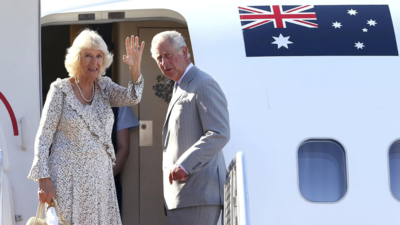King Charles III and Queen Camilla arrived in Sydney on Friday, making it the first visit by an active British monarch to Australia in over ten years, reported the news agency AP.
Their six-day visit has reignited conversations about Australia’s constitutional relationship with the British crown.
Australia’s debate over the monarchy is longstanding. In a 1999 referendum, Australians voted to retain Queen Elizabeth II as head of state, though the result was seen as more of a disagreement over how a president should be selected rather than a show of widespread support for the monarchy.
King Charles III, 75, who is undergoing cancer treatment, is the second reigning monarch to visit Australia, following in the footsteps of his mother, Queen Elizabeth II, who first visited 70 years ago.However, many of Australia’s political leaders are pushing for change, advocating for the removal of the monarchy from the nation’s constitution.
At 27, Queen Elizabeth II embarked on her challenging first tour of Australia, visiting numerous remote Outback towns, with around 75 per cent of the country’s population attending her performances.
At that time, Australia had an immigration policy that favoured British immigrants based on race. Since 1973, immigration policy has been free from discrimination.
In a symbolic gesture, the iconic sails of the Sydney Opera House will be illuminated with images from previous royal visits, reflecting the historical connection between the nations.
The premiers of all six Australian states have declined invitations to attend a reception for Charles III in Canberra, citing other commitments. Benwell criticised their absence as a snub, pointing out that this was the first visit by a reigning king to Australia.
However, the Australian Republic Movement (ARM) is using the visit as an opportunity to rally support for an Australian head of state. ARM launched a campaign titled “Wave Goodbye to Royal Reign with Monarchy: The Farewell Oz Tour!” co-chair Esther Anatolitis remarked that royal visits feel more like a show coming to town than a connection to their head of state.
Anatolitis pointed out that Australia is now much more multicultural, with a significant portion of the population either born abroad or having at least one overseas-born parent.
“In the 1950s, we lacked the level of global interconnectedness that exists today,” she remarked.
She emphasised that Australia deserves a full-time, locally-based head of state
Monarchists, on the other hand, hope the royal visit will strengthen Australians’ bond with the monarchy. Philip Benwell, chair of the Australian Monarchist League, believes the king’s presence will remind Australians of their constitutional monarchy. “The visit by the king brings it home that Australia is a constitutional monarchy and it has a king,” he said.
Following his visit to Sydney and Canberra, King Charles III will travel to Samoa to open the Commonwealth Heads of Government Meeting, continuing the royal tradition of fostering ties within the Commonwealth.
However, as Australia becomes more multicultural and globally interconnected, the question of its constitutional future looms larger.
